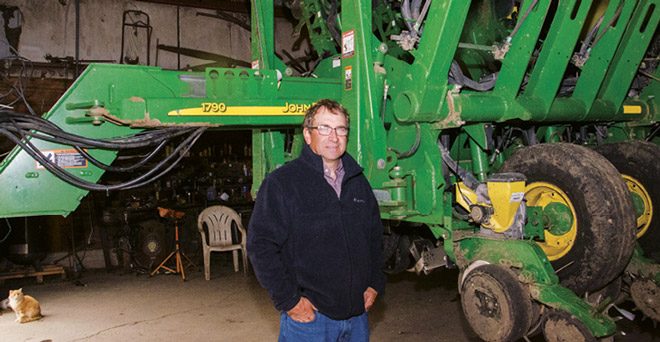Pictured Above: NO-TILL SUCCESS. Randy DeSutter uses his John Deere 1790 16/32 split-row planter for 15-inch row soybeans. He knows the 15-inch rows help not only to leave a tighter canopy for weed suppression, but also protect against erosion, which is imperative for his hilly acres.
Having no-tilled for over 25 years, Illinois grower Randy DeSutter knows the benefits of nutrient replenishment, decreased soil erosion and lower machinery costs associated with his farming practices. He simply uses his local Henry County corn and soybean yield averages to gauge his success.
“I always compare my yields to the county averages. Last year we were about 10 bushels better on soybeans and 25-30 bushels better on corn than the county average. That’s what I use my yardstick against,” says DeSutter, of Woodhull.
The 2016 averages in Henry County were 208 bushels per acre for corn and 61 bushels for soybeans.
Prompted by the 1985 Farm Bill that required farmers with highly erodible land to have a conservation plan, DeSutter saw no yield drop after adopting no-till in those initially targeted erodible lands, so it convinced him to go 100% no-till soon after.
Between all of the family members, including his brothers Jim and Mike, son Matthew and nephew Drew, the DeSutters manage 5,600 acres of 50/50 soybeans and corn.
Experimenting with Covers
Last fall the Illinois Corn Growers Association was offering financial incentives to seed cover crops, a program with a stated goal of helping farmers reduce nitrate (N) losses by 15% and phosphate (P) losses by 25% by 2025.
The DeSutters decided to take advantage. Last year they had oats and tillage radishes flown on 120 acres of both corn and soybeans around Sept. 1. They grew really well, Randy says, were excellent cover and the oats and radishes winterkilled as expected after some hard freezes.
“We were disappointed, however, that the tender for the airplane apparently didn’t get cleaned out and there was some rye in our mix,” he notes. “We had to spray that in the spring.
“My advice would be to talk to your supplier and make sure the custom applicator gets things get cleaned out thoroughly. I think something like the oats and radishes that winterkill are good for the beginner and people that don’t want to worry about terminating in the spring.”
Randy says there’s no doubt that the cover crops help control erosion, but they are waiting for this year’s crop yield to determine if the covers provided any significant yield increases.
“I know there are all kinds of combinations and it’s a whole new science to learn. I think if I was get into it, I might have it spread with my fertilizer as soon as I harvest because it doesn’t cost any extra for application,” he says. “I know some guys seed them, but we’re not set up enough to have somebody out seeding while we’re harvesting.”
Nutrient Savings
A combination of well-established buffer strips to protect creek beds and extensive tiling helps Randy keep his nutrients on the field. “We variable rate our fertilizer based on the soil test that we grid sample every 4 years,” DeSutter says.
This includes potassium (K) and P with micronutrients added as well. “We put our fertilizer on ahead of corn and then have it carry over into the next year for soybeans, so we only have one application every 2 years,” he explains.
Anhydrous ammonia with N-Serve stabilizer is applied in the fall followed by 50 units of 28% N at burndown in the spring.
DeSutter’s GPS-enabled John Deere 4038 sprayer has swath control to avoid any overlapping during spraying, such as the field ends.
“I estimate that I save 10 to 20% on chemicals from not over applying,” he says. “It automatically shuts off when certain sections are done. And there’s a lot less fatigue, too, because you don’t have to be watching and worrying all the time. You know you’re in the right spot.”
No-Till Answers
DeSutter says farmers will always look across the fence to see what the other guy’s doing. He understands that there’s active curiosity in what he’s achieving with no-till.
“People have this thought that you can’t have crops coming up unless that field is clean and black, so that’s a big adjustment to make when considering no-till,” he says. “But the guys that are doing tillage, I would estimate have to produce 10 bushels more per acre than me due to all the extra labor and machinery. And we’re doing a lot better than the county averages anyway.”





Post a comment
Report Abusive Comment